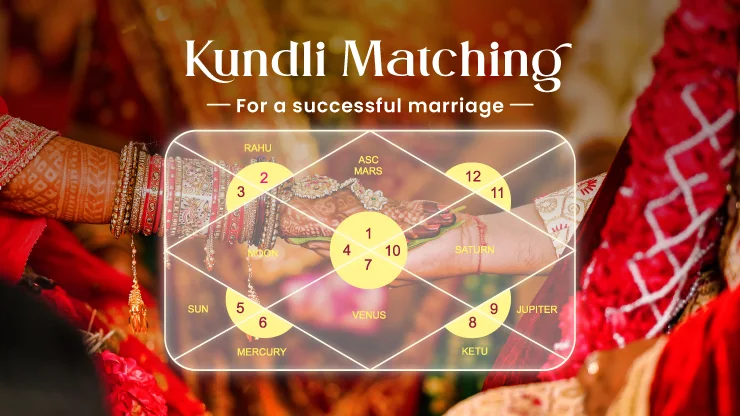Kundli Matching for Marriage: Concept Behind Gunas and Doshas

Long before astrology became a buzzword on apps and social media, kundli matching was quietly guiding how people understood human compatibility. It’s an ancient Vedic system that studies the planetary map drawn at the moment of birth, a map believed to influence emotions, temperament, health, and the rhythm of life itself.
Astrologers break this alignment down using two main tools: the eight gunas, which score compatibility across personality, mindset, and energy, and the doshas, which reveal where hidden imbalances could surface later. Instead of vague predictions, it works like a scorecard that highlights strengths and potential friction points between charts.
What makes it fascinating now is how this age-old method has evolved. Modern astrology uses the same framework but layers it with practical fixes and clear analysis, making it more insightful than ever. Let us now explore through the meaning of each guna, the impact of key doshas, and the smart remedies used now to balance them. By the end, you’ll see kundli matching not as a ritual, but as a clear lens to understand cosmic compatibility in everyday life.
What is Kundli Matching?
Kundali matching for marriage, also known as Guna Milan, is one of the oldest and most detailed ways astrology tries to decode human compatibility. It works by comparing and analysing birth charts, each a snapshot of the sky at the exact moment someone was born. These charts capture the position of the Moon in different nakshatras (lunar constellations), and those positions shape how a person thinks, feels, reacts, and builds relationships.
Astrologers then measure how well these two charts align using a structured scoring system called the Ashtakoota method. It breaks compatibility into eight gunas, each reflecting a different layer of life, from emotional bonding to temperament, health, prosperity, and future growth. Every guna carries a certain number of points, adding up to a total of 36. The higher the combined score, the more naturally the two personalities are believed to sync.
If two kundlis don’t align in gunas, even small disagreements can grow louder over time. That’s why many now turn to online kundali matching tools, not to predict the future, but to see how two life patterns might move together or drift apart, and how to balance them if needed.
The 8 Gunas in Kundali Matching for Marriage
In kundli matching, astrologers rely on the Ashtakoota system, a framework that studies compatibility through eight distinct parameters called gunas. Instead of looking at a chart as a whole, it breaks it into layers like mindset, emotions, health, and family outlook. Each guna carries a certain weight, and their combined points add up to 36. This overall score helps astrologers see where two charts naturally align and where they might need balance.
Here’s what each guna means in simple terms:
- Varna (1 Point) – This checks spiritual and social outlook. It shows whether two people share similar values, beliefs, and ways of thinking. If they align here, they usually understand each other’s perspectives easily.
- Vashya (2 Points) – This reflects influence and attraction between the two. A good score here means both partners can cooperate and adjust, instead of trying to control each other.
- Tara / Dina (3 Points) – This measures the balance of destiny and overall well-being. It shows how each person’s luck and health patterns affect the other, helping astrologers see if their paths support or strain each other.
- Yoni (4 Points) – This relates to emotional and physical compatibility. It helps reveal how naturally two people connect on an intimate and affectionate level.
- Graha Maitri (5 Points) – This looks at the mental connection. If this score is high, the couple is likely to share similar thinking styles, emotional responses, and friendship-like bonding.
- Gana (6 Points) – This represents temperament and personality types. A strong match here means fewer ego clashes and smoother day-to-day interactions.
- Bhakoot (7 Points) – This checks financial and family-related compatibility. It shows whether their combined energies will support stability, growth, and shared responsibilities.
- Nadi (8 Points) – This is considered the most important guna. It relates to health, genes, and the well-being of future children. A mismatch here, called Nadi dosha, can be a serious concern but often comes with remedies.
Astrologers generally see a combined score of 18 or more out of 36 as acceptable. Anything lower suggests major differences, while a high score indicates strong natural alignment. Kundali matching by name and date of birth uses this same system to quickly calculate how well two charts align before looking deeper into doshas.
Doshas in Kundli Matching
Matching 18 or more gunas is a good sign, but that’s not the whole picture. Sometimes, even if the guna score looks perfect, certain doshas in kundli matching can still affect married life. These are specific planetary imbalances that astrologers check closely while doing kundli matching by name and date of birth.
- Manglik Dosha (Mangal Dosh) – This happens when Mars sits in certain key houses in the birth chart. It’s believed to create tension, delays, or frequent disagreements in marriage if left unaddressed.
- Kaal Sarp Dosh – This forms when all planets are placed between Rahu and Ketu. It’s often linked to instability, emotional stress, and sudden obstacles in personal life.
- Nadi Dosha – This occurs when both partners belong to the same nadi. Astrologers say it can affect the couple’s compatibility and may cause health issues or problems in having children.
The presence of a dosha doesn’t mean a relationship is doomed. With proper remedies and guidance from an astrologer, these doshas can be balanced or neutralised so they don’t interfere with the marriage.
Modern Fixes & Remedies for Doshas
Astrology today mixes ancient principles with practical solutions, so couples don’t have to panic if doshas in kundli show up during kundli matching. The idea isn’t to erase fate, but to balance these planetary influences so they don’t disturb married life. Here are the most common remedies explained simply:
- Manglik Dosha Remedies: To balance this fiery energy, rituals like Mangal Shanti Puja are performed to calm Mars’s influence. Many people also observe fasts on Tuesdays (the day ruled by Mars), chant Hanuman Chalisa, or wear a red coral gemstone after consulting an astrologer. In some cases, marrying another Manglik person is advised so their energies neutralise each other, reducing the risk of marital conflict.
- Kaal Sarp Dosh Remedies: Astrologers often recommend specific pujas like Kaal Sarp Shanti, Rudrabhishek at Shiva temples, and reciting mantras such as Maha Mrityunjaya. Wearing gemstones like Gomed (Hessonite) or Cat’s Eye under expert guidance is also believed to help. These remedies aim to balance the disruptive pull of Rahu and Ketu and restore harmony in a person’s life.
- Nadi Dosha Remedies: To reduce its effects, rituals like Nadi Dosh Nivaran Puja are performed, and donations of food, clothes, or money are made to Brahmins. Some astrologers also suggest seeking blessings from elders or family priests to spiritually safeguard the couple’s married life.
Kundli Matching in Modern Times
The way people look at kundli matching has changed a lot from what it used to be. Earlier, families relied solely on astrological charts to decide if two individuals could marry. Today, while those traditional principles are still respected, couples also weigh factors like emotional understanding, shared life goals, communication styles, and personal values before making a commitment. Astrology has shifted from being a strict gatekeeper to becoming a guiding tool that works alongside practical considerations.
An Accurate Astrology platform like Neo Astro has made this process easier and more transparent. They offer detailed birth chart analysis, personalised marriage compatibility reports, and even dosha remedies suggested by experienced Jyotish and Vedic astrologers. This blend of old and new ensures couples get a clear, well-rounded perspective before taking the next step.
If you’re ready to see how your stars align, explore Neo Astro and get your kundli matched by trusted experts today! Because understanding your cosmic connection can be the first step toward a balanced and lasting bond.
Kundali Matching for Marriage - FAQs
What is the minimum score required in kundli matching?

In the traditional step-by-step kundli matching system, a score of 18 or more out of 36 gunas is considered acceptable for marriage. While a higher score indicates stronger compatibility, lower scores can still work if other aspects of the relationship align well.
Can doshas ruin a marriage completely?

Not necessarily. Doshas in kundli can create challenges, but they rarely decide the entire fate of a marriage. With timely remedies, guidance from astrologers, and mutual understanding, their negative effects can be significantly reduced.
What if online kundli matching fails, but the couple is compatible emotionally?

Even if online kundli matching shows low points, emotional compatibility plays a major role in a successful relationship. Many modern astrologers suggest using astrology as a guide while prioritising trust, respect, and shared life goals.
Is kundli matching necessary for love marriages?

While not mandatory, kundli matching for marriage can still be helpful in love marriages. It highlights potential issues like doshas or planetary conflicts and offers remedies to maintain long-term harmony between partners.
Can kundli matching for marriage predict divorce?

No. Kundli matching doesn’t directly predict divorce. It only identifies areas where conflicts might arise, giving couples a chance to understand each other better and take preventive steps to build a stronger bond.
